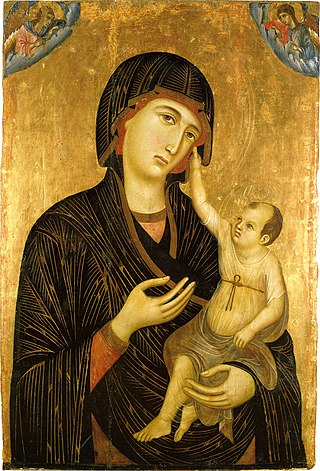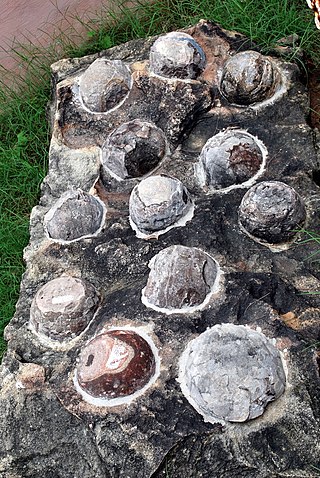
Oil painting is a painting method involving the procedure of painting with pigments with a medium of drying oil as the binder. It has been the most common technique for artistic painting on canvas, wood panel or copper for several centuries, spreading from Europe to the rest of the world. The advantages of oil for painting images include "greater flexibility, richer and denser color, the use of layers, and a wider range from light to dark". But the process is slower, especially when one layer of paint needs to be allowed to dry before another is applied.

Paint is a material or mixture that, when applied to a solid material and allowed to dry, adds a film-like layer. As art, this is used to create an image or images known as a painting. Paint can be made in many colors and types. Most paints are either oil-based or water-based, and each has distinct characteristics.

Tempera, also known as egg tempera, is a permanent, fast-drying painting medium consisting of pigments mixed with a water-soluble binder medium, usually glutinous material such as egg yolk. Tempera also refers to the paintings done in this medium. Tempera paintings are very long-lasting, and examples from the first century AD still exist. Egg tempera was a primary method of painting until after 1500 when it was superseded by oil painting. A paint consisting of pigment and binder commonly used in the United States as poster paint is also often referred to as "tempera paint", although the binders in this paint are different from traditional tempera paint.

Egg decorating is the art or craft of decorating eggs. It has been a popular art form throughout history because of the attractive, smooth, oval shape of the egg, and the ancient associations with eggs as a religious and cultural symbol. Egg decorating has been associated with Easter in recent times, but was practiced independently by many ancient cultures.

An egg is an organic vessel grown by an animal to carry a possibly fertilized egg cell and to incubate from it an embryo within the egg until the embryo has become an animal fetus that can survive on its own, at which point the animal hatches.

Oil paint is a type of slow-drying paint that consists of particles of pigment suspended in a drying oil, commonly linseed oil. Oil paint also has practical advantages over other paints, mainly because it is waterproof.

Robin egg blue, also called eggshell blue or robin's-egg blue, is a shade of teal, approximating the shade of the eggs laid by the American robin, an abundant songbird of North America. The egg pigment is biliverdin, a product of the breakdown of heme.

An eggshell is the outer covering of a hard-shelled egg and of some forms of eggs with soft outer coats.

The tradition of egg decoration in Slavic cultures originated in pagan times, and was transformed by the process of religious syncretism into the Christian Easter egg. Over time, many new techniques were added. Some versions of these decorated eggs have retained their pagan symbolism, while others have added Christian symbols and motifs.

Bird eggs are laid by the females and range in quantity from one to up to seventeen. Clutch size may vary latitudinally within a species. Some birds lay eggs even when the eggs have not been fertilized; it is not uncommon for pet owners to find their lone bird nesting on a clutch of infertile eggs, which are sometimes called wind-eggs.

Dinosaur eggs are the organic vessels in which a dinosaur embryo develops. When the first scientifically documented remains of non-avian dinosaurs were being described in England during the 1820s, it was presumed that dinosaurs had laid eggs because they were reptiles. In 1859, the first scientifically documented dinosaur egg fossils were discovered in France by Jean-Jacques Poech, although they were mistaken for giant bird eggs.
There are three types of color mixing models, depending on the relative brightness of the resultant mixture: additive, subtractive, and average. In these models, mixing black and white will yield white, black and gray, respectively. Physical mixing processes, e.g. mixing light beams or oil paints, will follow one or a hybrid of these 3 models. Each mixing model is associated with several color models, depending on the approximate primary colors used. The most common color models are optimized to human trichromatic color vision, therefore comprising three primary colors.

Humans and their hominid relatives have consumed eggs for millions of years. The most widely consumed eggs are those of fowl, especially chickens. People in Southeast Asia began harvesting chicken eggs for food by 1500 BCE. Eggs of other birds, such as ducks and ostriches, are eaten regularly but much less commonly than those of chickens. People may also eat the eggs of reptiles, amphibians, and fish. Fish eggs consumed as food are known as roe or caviar.

Shades of white are colors that differ only slightly from pure white. Variations of white include what are commonly termed off-white colors, which may be considered part of a neutral color scheme.

Macroolithus is an oogenus of dinosaur egg belonging to the oofamily Elongatoolithidae. The type oospecies, M. rugustus, was originally described under the now-defunct oogenus name Oolithes. Three other oospecies are known: M. yaotunensis, M. mutabilis, and M. lashuyuanensis. They are relatively large, elongated eggs with a two-layered eggshell. Their nests consist of large, concentric rings of paired eggs. There is evidence of blue-green pigmentation in its shell, which may have helped camouflage the nests.

The color cyan, a greenish-blue, has notable tints and shades. It is one of the subtractive primary colors along with magenta, and yellow.

Egg paleopathology is the study of evidence for illness, injury, and deformity in fossilized eggs. A variety of pathological conditions afflicting eggs have been documented in the fossil record. Examples include eggshell of abnormal thickness and fossil eggs with multiple layers of eggshell. The identification of egg paleopathologies is complicated by the fact that even healthy eggs can be modified during or after fossilization. Paleontologists can use techniques like cathodoluminescence or thin sectioning to identify true paleopathologies in fossil eggs. Despite the diversity of paleopathologies known from fossil eggs, the vast majority of conditions known to afflict modern eggs have not yet been seen among fossils.

Egg taphonomy is the study of the decomposition and fossilization of eggs. The processes of egg taphonomy begin when the egg either hatches or dies. Eggshell fragments are robust and can often travel great distances before burial. More complete egg specimens gradually begin to fill with sediment, which hardens as minerals precipitate out of water percolating through pores or cracks in the shell. Throughout the fossilization process the calcium carbonate composing the eggshell generally remains unchanged, allowing scientists to study its original structure. However, egg fossils buried under sediments at great depth can be subjected to heat, pressure and chemical processes that can alter the structure of its shell through a process called diagenesis.
Eggshell is the covering of an egg.

Haint blue is a collection of pale shades of blue-green that are traditionally used to paint porch ceilings in the Southern United States. Hex #D1EAEB is a popular shade of haint blue.















